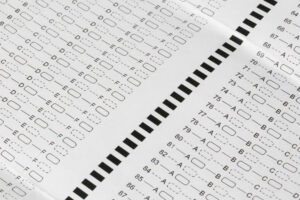2:00
News Story
Charter school student equity still lags, but new schools are helping close gaps
Legislation passed in 2019 requiring new charter schools to target historically underserved student groups is seeing an impact, new state enrollment data suggests.
One-tenth (10%) of state-authorized charter school students in Nevada are considered English language learners, 10.4% are considered students with disabilities, and 50.9% are considered economically disadvantaged. All three percentages are up from prior years.
Those student populations still lag behind enrollment in the state as a whole, where 13.8% of students are classified as ELL, 13.6% are considered students with disabilities, and 81.5% are considered economically disadvantaged.
But among charter schools that have opened since 2020, enrollment in these key student groups is much stronger and helping the quasi-district move toward equity in its student demographics.
During the 2019 Legislative Session, Nevada lawmakers briefly considered a moratorium on new charter schools. After they were met with significant pushback, they pivoted to legislation that required state authorizers to create a “demographic needs assessment” and prioritize the opening of charter schools in neighborhoods with low-performing district schools and high populations of historically underserved student populations.
The Nevada State Public Charter School Authority (SPCSA), which authorizes and oversees the vast majority of the charter schools across the state, began using the demographic needs assessment to approve proposed schools for the 2020-21 school year.
Demographic data collected this fall shows that among the charter schools approved under those new requirements, 20.9% were considered ELL students. That is double the overall ELL enrollment in charters, which sits at 10%, and higher than the overall state enrollment of ELL students, which sits at 13.8%.
Similarly, 81.4% of students at newly opened charter schools were classified as economically disadvantaged, which is defined as students who qualify for the federal free and reduced lunch (FRL). Among all state-authorized charters, 50.9% are classified FRL.
One important caveat regarding the number of FRL students: 60% of schools across the state are considered 100% FRL populations because they have qualified under the federal government’s “community eligibility provision,” which allows schools to automatically qualify as 100% FRL if a certain percentage of their students qualify automatically through enrollment in income-based social service programs like SNAP. Only one-fifth (20%) of state-authorized charter schools are CEP schools.
To what extent CEP classifications impact the total student count is unclear, say charter school authority staff.
While newly opened charter schools appear to be helping close equity gaps among ELL and FRL students, the same does not appear to be true of students with disabilities, which includes any student with an ‘individualized education plan’ (IEP) that requires schools to provide some level of accommodation.
Newly opened charter schools reported 10.1% of their students have IEPs, compared to 10.4% of all charter schools and 13.6% of all public school students.
The Nevada State Public Charter School Authority now enrolls 12.7% of all K-12 public school students in the state, according to the official enrollment count. That makes the Charter School Authority the third largest school district in Nevada, behind Washoe County School District, which enrolls 13.3% of students.
The Charter School Authority enrolled 61,883 students for the 2023-24 academic year. That’s a 3.7% change over the prior year, which is slower than the prior year’s growth rate of 7.7%.
Approximately 2,800 students now separate the Charter School Authority and WCSD.
Clark County School District is by far the largest in Nevada, enrolling 63.7% of students. Nevada’s rural school districts enroll 10.2% of students.
Gil Lopez, the executive director of the Charter School Association of Nevada, says the size of the charter school population “leads to a bigger conversation.”
“Charters are here,” he said. “We’re part of the fabric of education. We have high achieving students. Sometimes we feel left out. We are not taken into consideration. But the sheer size, and with the growth, the state will have to take note.”
Nationally, the charter school population grew approximately 2% while traditional school district enrollment remained flat, according to a report released earlier this month by the National Alliance for Public Charter Schools.
Nevada’s official enrollment counts are determined around Oct. 1 of each year, on a day designated by the Nevada Department of Education as “validation day.” The data, which includes number of students and demographic data, are used for a variety of purposes, including state and federal funding amounts.
The NDOE reports private school enrollment separately, and home schooled students are not tracked at the state level.
Our stories may be republished online or in print under Creative Commons license CC BY-NC-ND 4.0. We ask that you edit only for style or to shorten, provide proper attribution and link to our website. AP and Getty images may not be republished. Please see our republishing guidelines for use of any other photos and graphics.




